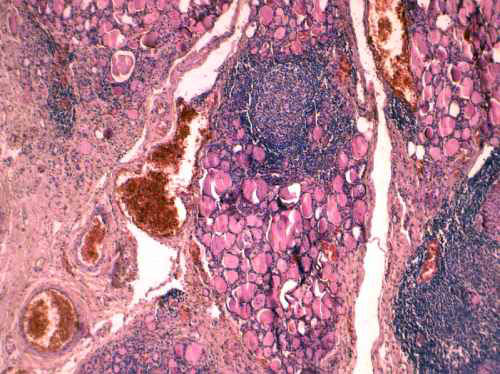- Hashimoto's thyroiditis
Infobox_Disease
Name = Hashimoto's thyroiditis

Caption = Histology
DiseasesDB = 5649
ICD10 = ICD10|E|06|3|e|00
ICD9 = ICD9|245.2
ICDO =
OMIM = 140300
MedlinePlus =
eMedicineSubj = med
eMedicineTopic = 949
MeshID = D050031Hashimoto's thyroiditis or chronic lymphocytic thyroiditis is an
autoimmune disease where the body's own T-cells attack the cells of thethyroid . It was the first disease to be recognised as an autoimmune disease.This disorder is believed to be the most common cause of primary
hypothyroid ism inNorth America . It occurs far more often in women than in men (10:1 to 20:1), and is most prevalent between 45 and 65 years of age.In European countries, an
atrophic form ofautoimmune thyroiditis (Ord's thyroiditis ) is more common than Hashimoto's thyroiditis.Causes
The family history of thyroid disorders is common, with the "HLA-DR5" gene most strongly implicated conferring a
relative risk of 3 in the UK. In addition Hashimoto's throiditis may be associated with "CTLA-4" gene since the CTLA-4 antigen acts as an inhibitor to T-Cell activation.The genes implicated vary in different ethnic groups and the incidence is increased in patients with chromosomal disorders, including Turner, Down's, and
Klinefelter's syndrome s.The underlying specifics of the immune system destruction of thyroid cells is not clearly understood. Various autoantibodies may be present against
thyroid peroxidase ,thyroglobulin andTSH receptors , although a small percentage of patients may have none of these antibodies present. A percentage of the population may also have these antibodies without developing Hashimoto's thyroiditis.Presentation
In many cases, Hashimoto's thyroiditis results in
hypothyroidism , although in its acute phase, it can cause a transient hyperthyroidism thyrotoxic state known as hashitoxicosis.Physiologically, antibodies against
thyroid peroxidase and/orthyroglobulin cause gradual destruction of follicles in thethyroid gland. Accordingly, the disease can be detected clinically by looking for these antibodies in the blood. It is also characterized by invasion of the thyroid tissue byleukocytes , mainly T-lymphocytes. It is associated withnon-Hodgkin lymphoma .Symptoms of Hashimoto's thyroiditis might include symptoms of hyperthyroidism in the early phase of the disease, and then hypothyroidism. Weight gain, depression, mania, fatigue, panic attacks,
bradycardia ,tachycardia , high cholesterol, reactive hypoglycemia, constipation, migraines, memory loss, infertility and hair loss are a few possible symptoms. Hashimoto's thyroiditis is often misdiagnosed as bipolar disorder and, less frequently, as anxiety disorder. Testing for anti-thyroid antibodies can resolve any diagnostic difficulty. [ AJ Giannini. The Biological Foundations of Clinical Psychiatry. New Hyde Park, NY. Medical Examination Publishing Co., 1986. ]Treatment
Hypothyroidism caused by Hashimoto's Thyroiditis is treated with thyroid hormone replacement. A small pill taken once a day should be able to keep the thyroid hormone levels normal. This medicine will, in most cases, need to be taken for the rest of the patient's life.
Eponym
[

Kyushu University ] Also known as Hashimoto's disease, Hashimoto's thyroiditis is named after theJapan ese physicianHashimoto Hakaru (1881−1934) of the medical school atKyushu University , [WhoNamedIt|doctor|1974|Hakaru Hashimoto] who first described the symptoms in 1912 in a German publication [H. Hashimoto: "Zur Kenntnis der lymphomatösen Veränderung der Schilddrüse (Struma lymphomatosa)." Archiv für klinische Chirurgie, Berlin, 1912, 97: 219−248.] .Possible complications
If untreated for an extended period, Hashimoto's thyroiditis may lead to muscle failure, including possible heart failure.
References
External links
* [http://www.mayoclinic.com/health/hashimotos-disease/DS00567 Hashimoto's disease] at the
Mayo Clinic
* [http://www.thyroidproblems.org/hashimotos.php Hashimoto's Thyroiditis]
* [http://www.ahsta.com Alternative Health Solutions for Thyroid Autoimmunity]
* [http://www.elaine-moore.com Elaine Moore Graves' and Autoimmune Disease Education]
Wikimedia Foundation. 2010.
